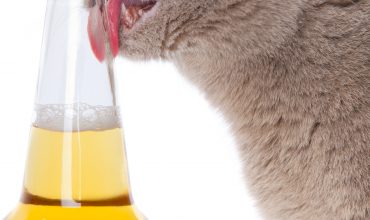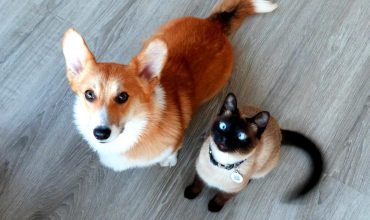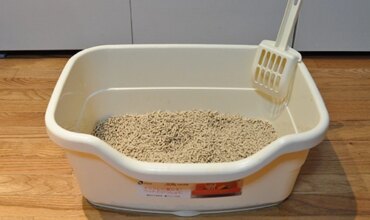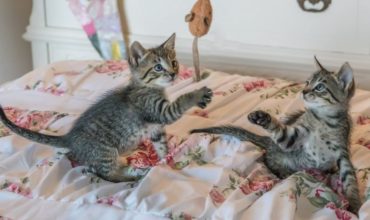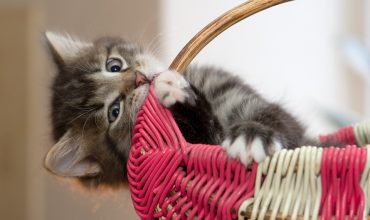Herbie Adopted late September 2015. Rescued to relaxing.
Read More
Monthly Archives February 2018
Trivia with Cats
Cuddle up to furry friends, enjoy beer and wine, and snack on popcorn while you play trivia at the Tiny Lions cat café. Ages 18+ only.
Read More
Unusual eating habits in dogs and cats
[print-me] Dogs and cats will sometimes eat socks, rocks or other objects, which may result in a variety of problems for both you and your pet. Not only can your possessions be destroyed or damaged, but objects such as clothing and rocks can produce life-threatening blockages in your pet’s intestines. Eating non food items is called pica. A specific type of pic is stool eating (either their own or that of another animal) and, while not necessarily dangerous to the animal, is probably unacceptable to you. Stool eating is called coprophagy. The causes of pica and coprophagy are not known. Many ideas have been proposed by various experts, but none have been proven or disproven. Such behaviors may sometimes be attention-getting behaviors. If engaging in one of these behaviors results in some type of social interaction between the animal and his owner (even a verbal scolding) then the behavior may be reinforced and occur more frequently. These behaviors may be attempts to obtain a necessary nutrient lacking in the diet, although no nutritional studies have ever substantiated this idea. They may also stem from frustration or anxiety. It’s possible behaviors begin as play, as the animal investigates and chews on the objects, then subsequently begins to eat or ingest them. It has been suggested that coprophagy is carried over from the normal parental behavior of ingesting the waste of young offspring. Some experts believe coprophagy occurs more often in animals who live in relatively barren environments, are frequently confined to
Read More
House Soiling Or Urine-Marking? How To Tell The Difference!
[print-me] House Soiling Or Urine-Marking? How To Tell The Difference! Your pet may be urine-marking if: The problem is primarily urination. Dogs and cats rarely mark with feces. The amount of urine is small and is found primarily on vertical surfaces. Dogs and cats do sometimes mark on horizontal surfaces. Leg-lifting and spraying are common versions of urine-marking, but even if your pet doesn’t assume these postures, he may still be urine-marking. Any pet in your home is not spayed or neutered. Both intact males and females are more likely to urine-mark than are spayed or neutered animals. However, even spayed or neutered animals may mark in response to other intact animals in the
Read More
Positive Reinforcement: Training with treats and praise
[print-me] Positive reinforcement is the presentation of something pleasant or rewarding immediately following a behavior. It makes that behavior more likely to occur in the future, and is one of the most powerful tools for shaping or changing your pet’s behavior. Correct timing is essential when using positive reinforcement. The reward must occur immediately, or your pet may not associate it with the proper action. For example, if you have your dog sit, but reward him after he’s already stood up again, he’ll think he’s being rewarded for standing up. Consistency is also essential. Everyone in the family should use the same commands.
Read More
Selecting the right pet for you
[print-me] Puppies and kittens are babies. All babies are cute, cuddly and fun to watch whether they’re playing or sleeping. It’s wonderful to watch a baby grow, explore and learn. However, we can’t predict what kind of personality that baby will have as an adult. It’s impossible to look at the rows of human babies in a hospital nursery and know who will be athletic or academic, quiet or talkative, high or low energy, artistically or mechanically gifted, sociable or a “loner.” Many physical traits of certain types or breeds of dogs and cats can be fairly predictable. Some are good traits like size, coat and hair types, and some are bad, such as overbreeding, health problems and
Read More
Is now a good time to adopt a pet?
[print-me] Pets add fun, companionship and love to our lives, but they’re also a big responsibility. Choosing to add a pet to your family is a very important decision. Sometimes, adopting a pet may be too much added responsibility if you’re experiencing other life-changes at the same time. Take this quiz to assess what’s happening in your life now, and in the near future, to help you decide if this is the best time to adopt a pet. Check the following events that have either occurred in your life in the past six months, or that you think may occur in the coming six months: Divorce or end of a relationship Marriage Change in living arrangements (new roommates or moving in with significant other) Move to a new residence Pregnancy or new baby Longer hours or increased responsibility at work Financial concerns Children leaving home or moving back home Caretaking responsibilities for elderly or ill family member Significant changes in family routine Death of a family member Death or disappearance of a family pet Relinquishment of a pet (given away or brought to an animal shelter) Significant health problems of a family member Change in working status of a family member (begins work, changes jobs or retires) Frequent travel, either for business or pleasure Limited leisure or free time Graduation from high school or college Disagreement among family members about adopting a pet Add one point for every pet you currently have (one aquarium counts as one pet). Scoring 0-3: Your life seems fairly stable. Now is probably a reasonable time to acquire a pet. 4-6: You have a lot of responsibilities right now. Although adopting a pet may still work for you, a small mammal, an adult cat, or well-trained, adult dog would probably be more appropriate than a kitten, a puppy or an active breed of dog. 7-10: Let’s think twice about this. With all the changes and responsibilities in your life right now, you may not have time to care for a
Read More
Your new cat & the litter box
[print-me] Most cats have a specific preference about where they want to eliminate. By following the suggestions outlined here, you’ll be able to start off on the right foot with your new cat. Location The most important aspects of location are the need for it to be quiet, easily accessible, and not near the feeding and water stations or any comfort items. Most people are inclined to place the litter box in an out-of-the-way spot in order to minimize odor and loose particles of cat litter in the house. Often, the litter box ends up in the basement, sometimes next
Read More
Rough play in a kitten or adult cat
Is your kitten or cat playing too rough? Here's what to do.
Read More
Managing scratching
[print-me] By nature, cats have a need to scratch objects in their environment. We know that cats leave their scent behind when they scratch things and that this is a means of letting the world know that they’re there… whether it is to warn another cat away or to invite them to play. They tend to go back to the same spots and scratch those spots repeatedly for this reason; it’s another way for them to mark their territory. Even cats who have been declawed will try to scratch things for this very reason! Scratching also happens in play, as
Read More





